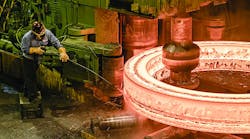Scot Forge
Spring Grove, IL
Forging
512 employees | 3 sites | 2 EHS professionals
Read profiles on all the other 2019 America's Safest Companies!
Scot Forge, an employee-owned provider of metal forging solutions, is no stranger to the America’s Safest Companies competition, having previously won the award in 2014. Over the past five years, the company has continued to strengthen its safety processes, teamwork and culture.
Scot Forge adheres to a “Brother’s Keeper” philosophy, where each employee looks out for each other. “As employee-owners, our first responsibility is to complete each task without compromising our own personal safety and the safety of others,” explains Joseph Lyons, safety leader. “We live this through looking out for one another, helping others and intervening when we recognize a hazard—behavioral or physical.”
All leaders at the company follow a “servant leadership” model to achieve the best possible outcome for employees and the organization. This is accomplished by ensuring that employees are equipped with the resources, tools, training and opportunities to improve themselves and their functional areas. Every employee meets at least once a month with their supervisor to discuss things like equipment safety and to suggest ideas for improving how work is being performed in their area.
For the past 20 years, Scot Forge has partnered with OSHA, and was the first forging company in the U.S. to gain OSHA’s SHARP designation (Consultation Safety and Health Achievement Recognition Program), which recognizes small businesses that have exemplary safety and health programs.
Among the company’s 512 employees, 90 of them serve as volunteer first responders, covering all locations and all shifts to provide medical care as needed. These individuals are trained in first aid, CPR and AED.
Scot Forge utilizes cloud-based safety technologies in several ways. For instance, a data platform provides a tool to complete equipment inspections on mobile devices, allowing team members to generate action items immediately after an equipment defect has been identified. The tool can also generate incident reports and identify at-risk conditions. Another cloud-based tool assists maintenance workers by creating visual procedures for lockout/tagout, confined spaces and other tasks.
“Although there is always risk in our industry, we teach our employees to stop the task at hand if it cannot be done safely,” Lyons says. “Our fundamental belief is that there is no task more important than the safety of our people.”

